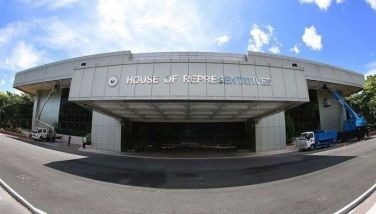‘Oceanfill’ feared in North Pacific due to ‘plastic boom’
April 1, 2006 | 12:00am
Former environment secretary Heherson Alvarez warned yesterday of an "oceanfill" in the North Pacific, as 14 billion pounds of garbage, consisting mostly of non-biodegradable plastic, are said to be dumped each year into the world’s oceans.
Citing the alarming discovery of scientists, Alvarez said that a three-million-ton mass of plastic debris, which may contain toxics like dichlorodiphenyltrichloroethane (DDT) and polychlorinated biphenyls (PCBs), is floating in the North Pacific’s subtropical gyre and continues to get bigger each year from plastic thrown by the Japanese, Canadians and Americans from their respective eastern and western Pacific coastal lands.
"While most of man’s garbage is thrown in landfills and dumpsites, scientists have learned that we have unknowingly been building an ‘oceanfill’ in the North Pacific since the "plastic boom" began in the 1950s and ’60s," said Alvarez, as the two-day technical working group assembly of the Asia-Europe Meeting (ASEM) Ocean Initiative in Makati City ended yesterday.
The Philippines is hosting the ASEM Ocean Initiative which counts 13 Asian countries and 25 European Union member-states in an international effort to save the world’s oceans and marine resources from depletion.
According to Alvarez, who is vice president for Southeast Asia of the Advisory Committee on Protection of the Seas (ACOPS), a United Kingdom-based non-government organization, the pollution from land-based sources is one of the major reasons for the depletion of marine ecosystems.
He asserted that even as nations and advocates talk of conservation efforts, the "creeping problem of pollution of the world’s seas" should already be addressed.
Alvarez, who is also founding chair of the EarthSavers Movement, pointed out that for the past 50 years or so, plastics that have made their way into the Pacific Ocean have been fragmenting and building up "as a kind of swirling sewer" in the North Pacific subtropical gyre.
Currents in the North Pacific move in a clockwise spiral, or gyre, which tends to trap debris originating from sources along the North Pacific rim, he explained.
Plastics and other waste have accumulated in the region, even in the foraging areas of Pacific bird colonies, such as that of the Tern Island albatross and the Guadalupe Island albatross.
Alvarez reminded the public that a plastic bag or plastic cup thrown into the garbage bin can find its way into the world’s oceans and seas and accumulate into a "floating sea of garbage."
"Each year, we join and organize ‘Clean Up the World events’ in the Philippines. During the coastal clean-up months of September and October, plastic is the number one item of concern making up well over 76 percent of the garbage collected," Alvarez said.
Citing the alarming discovery of scientists, Alvarez said that a three-million-ton mass of plastic debris, which may contain toxics like dichlorodiphenyltrichloroethane (DDT) and polychlorinated biphenyls (PCBs), is floating in the North Pacific’s subtropical gyre and continues to get bigger each year from plastic thrown by the Japanese, Canadians and Americans from their respective eastern and western Pacific coastal lands.
"While most of man’s garbage is thrown in landfills and dumpsites, scientists have learned that we have unknowingly been building an ‘oceanfill’ in the North Pacific since the "plastic boom" began in the 1950s and ’60s," said Alvarez, as the two-day technical working group assembly of the Asia-Europe Meeting (ASEM) Ocean Initiative in Makati City ended yesterday.
The Philippines is hosting the ASEM Ocean Initiative which counts 13 Asian countries and 25 European Union member-states in an international effort to save the world’s oceans and marine resources from depletion.
According to Alvarez, who is vice president for Southeast Asia of the Advisory Committee on Protection of the Seas (ACOPS), a United Kingdom-based non-government organization, the pollution from land-based sources is one of the major reasons for the depletion of marine ecosystems.
He asserted that even as nations and advocates talk of conservation efforts, the "creeping problem of pollution of the world’s seas" should already be addressed.
Alvarez, who is also founding chair of the EarthSavers Movement, pointed out that for the past 50 years or so, plastics that have made their way into the Pacific Ocean have been fragmenting and building up "as a kind of swirling sewer" in the North Pacific subtropical gyre.
Currents in the North Pacific move in a clockwise spiral, or gyre, which tends to trap debris originating from sources along the North Pacific rim, he explained.
Plastics and other waste have accumulated in the region, even in the foraging areas of Pacific bird colonies, such as that of the Tern Island albatross and the Guadalupe Island albatross.
Alvarez reminded the public that a plastic bag or plastic cup thrown into the garbage bin can find its way into the world’s oceans and seas and accumulate into a "floating sea of garbage."
"Each year, we join and organize ‘Clean Up the World events’ in the Philippines. During the coastal clean-up months of September and October, plastic is the number one item of concern making up well over 76 percent of the garbage collected," Alvarez said.
BrandSpace Articles
<
>
- Latest
- Trending
Trending
Latest
Trending
Latest
Recommended































